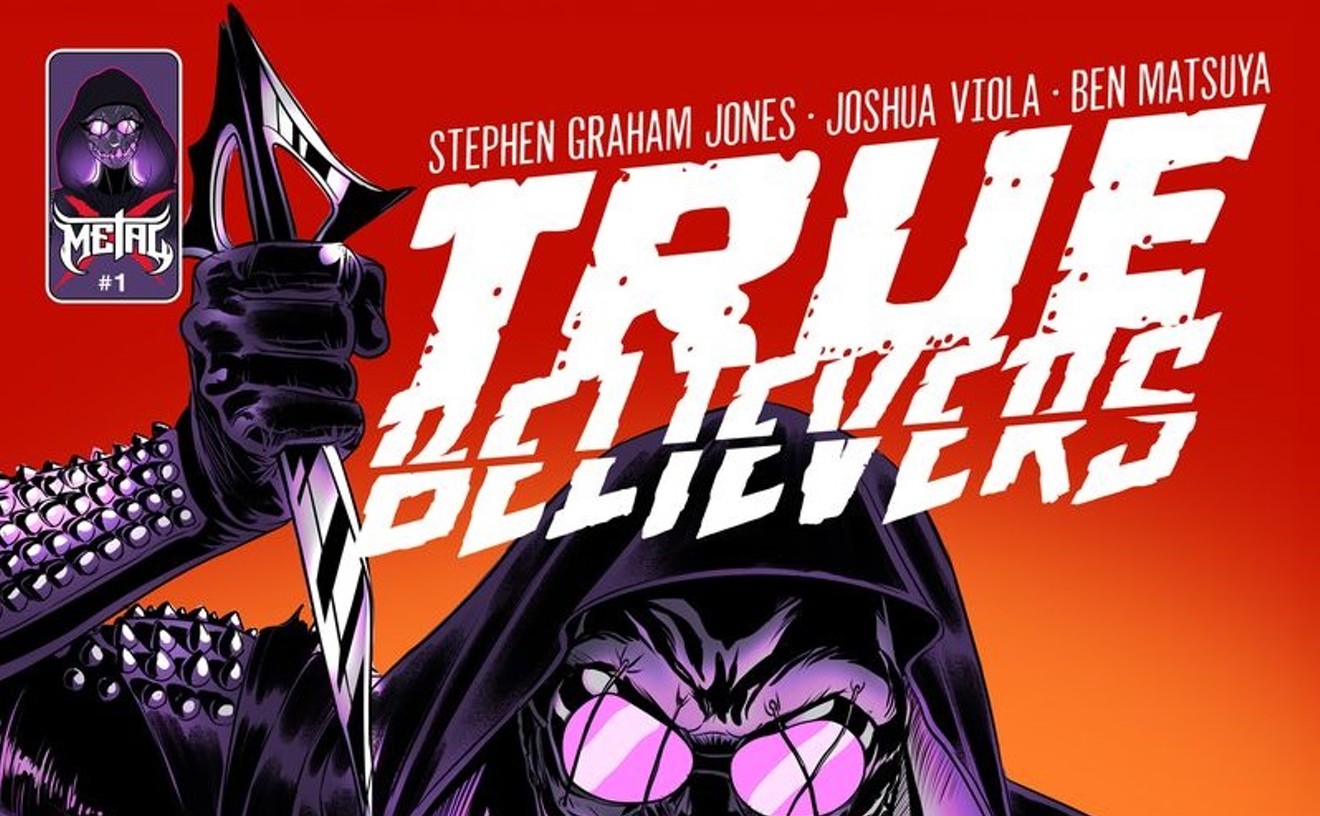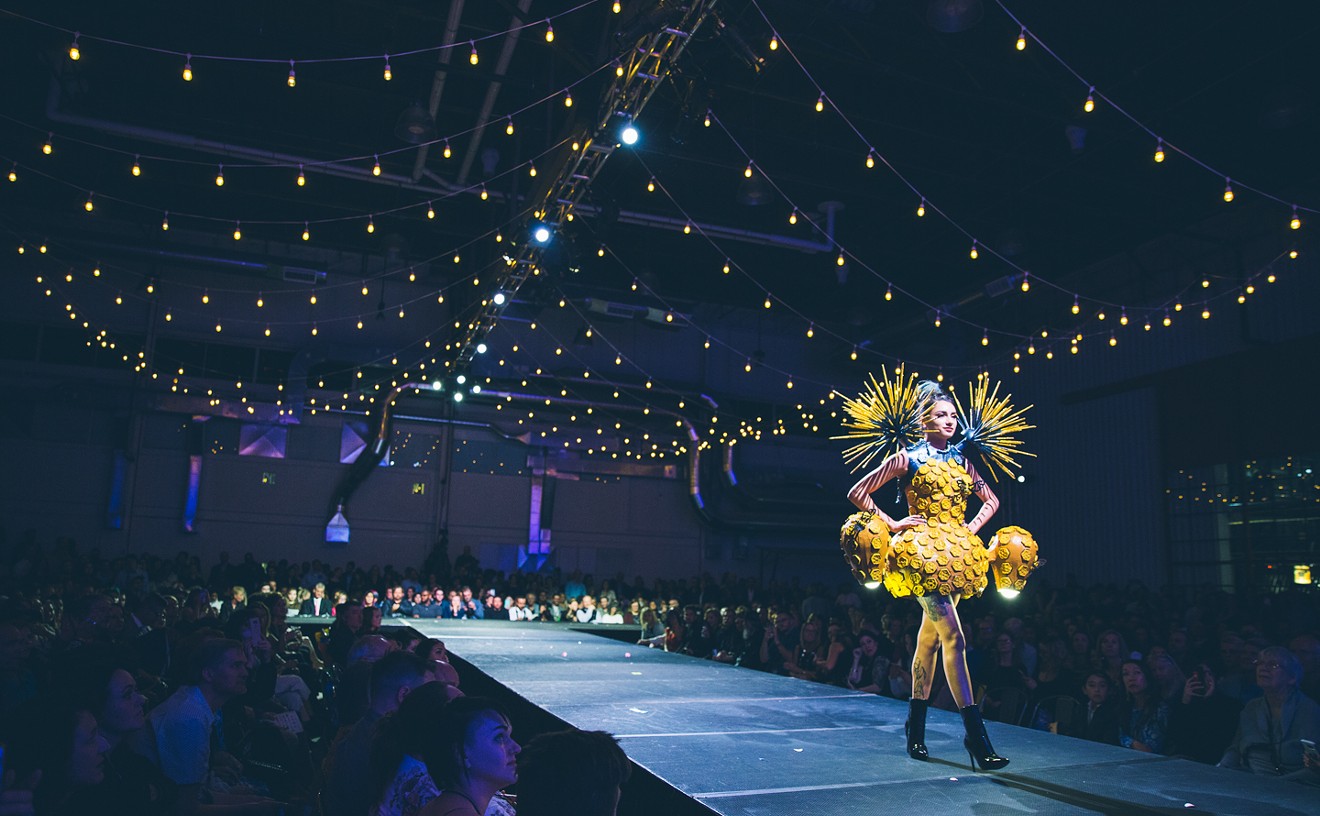Adam Helms. This solo in the MCA's Paper Works Gallery is the New York artist's first museum show anywhere. In his works on paper and in a monumental sculpture that conjures up a shooting blind, Helms explores political themes, especially armed struggle. He takes images of different radical and extremist movements from different places and times and makes copies of them. Then he combines them into singular images to create archetypes. In "Shadow: Portrait of a Jihadi," for instance, Helms has taken a shot of what looks like an American soldier in 1960s Vietnam and blackened out the face in the manner of the hooded Islamic terrorists of today. His technique is as interesting as his imagery, and in this piece, he has silkscreen-printed both sides of a sheet of translucent vellum, lending it an almost hallucinogenic character. Through January 18 at the MCA Denver, 1485 Delgany Street, 303-298-7554, www.mcadenver.org.
Clyfford Still Unveiled. A master and pioneer of mid-twentieth-century abstract expressionism, painter Clyfford Still was something of an eccentric in the artist-as-egomaniac stripe. His antisocial behavior led to a situation where 94 percent of his artworks remained together after he died — a staggeringly complete chronicle of his oeuvre that is now owned by the City of Denver. As a planned Clyfford Still Museum won't be completed until 2010, the institution's founding director, Dean Sobel, decided to preview a baker's dozen of Still's creations at the Denver Art Museum. Sobel uses the very small show to lay out most of the artist's career and stylistic development. Still worked his way from regionalism to surrealism, then wound up developing abstract expressionism with one of the greatest abstract paintings imaginable, "1944 N No. 1" — and the rest is art history. Through January 18 at the Denver Art Museum, 100 West 14th Avenue Parkway, 720-865-5000. Reviewed July 26, 2007.
Counterpoints et al. Jim Robischon and Jennifer Doran have put together an impressive abstract group exhibition, Counterpoints, that's headlined by two internationally famous artists who approach abstraction from opposite directions. On one side is the reductive genius of the late Gene Davis, the original stripe painter; on the other is the more-is-more approach preferred by Judy Pfaff. But apparently opposites do attract, because the two, each with multiple selections of pieces on paper hanging in spaces immediately adjacent to one another, look gorgeous together. The rest of the show is filled out by works that fall stylistically between the minimalism of Davis and the expressionism of Pfaff, including examples by Don Voisine, Robert Mangold, Pat Steir, Chris Gallagher, Dan Walsh and Reed Danzinger. Paired with Counterpoints is a smaller if equally compelling exhibit, Colorado Abstract, featuring the efforts in painting and sculpture of home state artists such as Terry Maker, Trine Bumiller, Scott Chamberlin, Halim Al-Karim, Tony Coulter, Carl Reed and Ana Maria Hernando. Through January 24 at Robischon Gallery, 1740 Wazee Street, 303-298-7788, www.RobischonGallery.com.
Damien Hirst. You'd have to be living under a rock — or have absolutely no interest in contemporary art — not to know that Damien Hirst is a superstar, and that everything he makes is worth millions of dollars apiece. The tight solo at MCA Denver (formerly known as the Museum of Contemporary Art/Denver) is not the first time that local art audiences have had a chance to see Hirst's creations in person, but it is his first single-artist show anywhere in the American West. Hirst's "Natural History" series of dead animals in cases is surely his most famous type of work. There's an incredible one in the MCA show called "Saint Sebastian: Exquisite Pain," made up of a bullock that's been pierced with arrows. It's simultaneously compelling and repellent. "Saint Sebastian" dominates the Large Works Gallery, but there are three other Hirst pieces, including two very different paintings from his "Butterfly" series, in which actual butterflies are affixed to the paintings, and one of his post-minimal "Medicine Cabinets." It's apparent that Hirst is brilliant, with an eye for beauty, though his mind goes in for ugliness. Through August 30 at MCA Denver, 1485 Delgany Street, 303-298-7554, www.mcadenver.org. Reviewed October 16.
Designing Women. The genesis for this surprisingly large show dates back to the late 1990s, when Denverites Jill Wiltse and Kirk Brown began to discover British production textiles from the 1950s. Driven with a passion, Wiltse and Brown avidly sought out more and more relevant examples, most of them purchased in London. The exhibit was organized by their personal curator, Shanna Shelby, working together with Tariana Navas-Nieves, a curator at the Colorado Springs Fine Arts Center. Textiles were a key part of the "New Look" that helped redefine Britain after World War II. Wiltse and Brown identified three key designers — Lucienne Day, Marian Mahler and Jacqueline Groag — and there are major sections of the show devoted to each. And although all three were stylistically related, Day in particular found her own new way, while Mahler and Groag both did work rooted in early continental modernism. Through January 25, Colorado Springs Fine Arts Center, 30 West Dale Street, Colorado Springs, 1-719-634-5581, www.csfineartscenter.org. Reviewed December 18.
Garden of Nineveh. Terry Maker is a well-known Boulder artist who's been exhibiting her extremely original pieces for the past 25 years. Beginning with the concept of "wants and desires" — Maker's and those of people in general — she created an installation with three distinct parts: an audio component and two different wall treatments. The first aspect, the soundtrack, was recorded at the museum itself, with visitors asked to talk about their private wants and desires. Though conceptually strong in light of her theme, the voice tracks are much less interesting than the visual effects. To start, Maker has painted the space black, with the two facing walls covered with bas-relief sculptures. In many ways, the two wall sculptures are visual and ideational opposites of each other. One is pointy and threatening, the other smooth and inviting. The pointy wall is about struggle, the smooth one abundance, with both inspired — despite the title — by the story of the expulsion from the Garden of Eden. Through January 18 at MCA Denver, 1485 Delgany Street, 303-298-7554, www.mcadenver.org. Reviewed December 4.
In Contemporary Rhythm: The Art of Ernest L. Blumenschein. It sounds like a preposterous moment in a cheesy Western. A couple of artists head out from Denver for Mexico by wagon, break down, and start an art colony that goes on strong for the next sixty years. It sounds made up, but it's true. In 1898, Ernest Blumenschein and his neighbor, Bert Phillips, broke down near Taos, and the rest is art history. The Denver Art Museum, in collaboration with the Albuquerque Museum of Art and History and the Phoenix Art Museum, has organized a major solo of Blumenschein's oeuvre called In Contemporary Rhythm: The Art of Ernest L. Blumenschein. The exhibit was co-curated by Elizabeth Cunningham and Peter Hassrick, director of the Petrie Institute of Western American Art at the DAM. The show is the most comprehensive exhibit on Blumenschein ever. It starts with his early work, done in Paris and New York at the turn of the century, then follows his Taos career through the 1950s. A gorgeous presentation, it proves that Blumenschein was a genuine painter's painter. Through February 8 at the Denver Art Museum, 100 West 14th Avenue Parkway, 720-865-5000, www.denverartmuseum.org. Reviewed November 20.
through a glass, darkly. The inaugural exhibition at Laura Merage's RedLine is through a glass, darkly, curated by Jenny Schlenzka, who's from Germany but lives in New York. The title was inspired by the classic Ingmar Bergman film of the same name, but Schlenzka discovered that the phrase is from the Bible. Watching the elections made her want to do a political show, though not everything here has an apparent message, especially the initial work, "Self-Portrait As Us," by Douglas Gordon, an altered publicity shot of the cast of the TV show Dynasty, set in Denver. Dynasty has a personal resonance for Schlenzka because it was her grandmother's favorite show — called Der Denver Clan in Germany. The one truly incredible piece in the show, and the only one that coherently expresses a political point of view, is by Annette Roberts-Gray, who lives not in Manhattan, London or Berlin, but in Glenwood Springs. It is a large set of shelves painted gray; on them are 1,000 hand-thrown porcelain vases, all impressed with the names of soldiers who died in Iraq and Afghanistan. Through January 16 at RedLine, 2350 Arapahoe Street, 303-296-4448, www.redlineart.org. Reviewed November 6.










